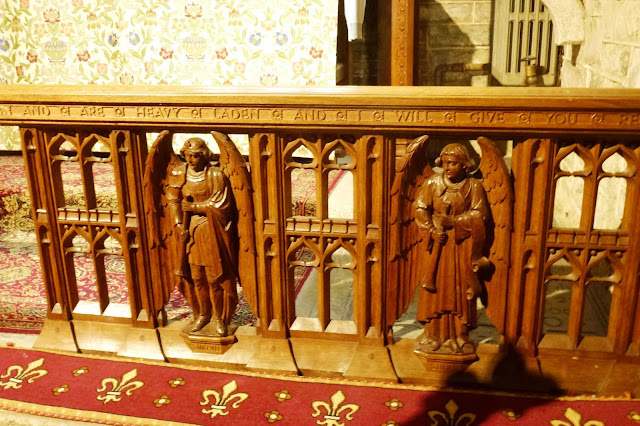Little stream/river running thru Okehampton
Little unassuming church plunked in the middle of the town,
couldn't find a date on this one -
liked that it was called an Ancient Mayoral Chapel
simple inside
stream thru another part of town
fisher boy patiently watching and waiting
Now on to Lydford Church and Castle. Historically Lydford was an economic powerhouse. The village was established as one of the four Saxon burhs of Devon by King Alfred the Great. It first appears in recorded history in 997, when the Danes made a plundering expedition up the Tamar and Tavy as far as Hlidaforda (i.e. Lydford). During the reign of Ethelred the Unready (don't you love that moniker), there was a coin mint here. At one time it was the most populous centre in Devonshire after Exeter, but after the Norman Conquest the town never recovered its former prosperity. According to the Domesday Book, Lydford was taxed equally with London, giving an idea of its significance at the time, the reason being that the parish of Lydford included the entire Forest of Dartmoor under the Normans. Until the 12th century parishioners from across more or less the entirety of Dartmoor were brought to Lydford for burial. The path used to make this final journey is known as the 'Lych way'. Many reports have been made of monks in white and phantom funeral processions seen walking along this path.
The first Christian church in Lydford was a wooden structure built c. 650 AD. It is probable that this church was burnt down by the Vikings in their raid of 997 AD. The church was later rebuilt, in the Norman style, but some of the architectural furniture, for example the font, were of the Anglo-Saxon style. The church was enlarged in the 13th century, the tower being added in the 15th century. A further enlargement occurred about 1890 with the addition of the vestry and northern aisle.
large mill wheel in the church yard
interesting graveyard with stones dating in the early 1700s
there were many of these small roundish grave markers that seemed to have runic markings on them
this one is from 1750
this from 1774
this was an interesting marker - sort of Stonehenge like - unable
to decipher the writing on top
this is the font that dates back to the early Saxon days
models of the church thru the centuries
the castle next door
layout of the nearby village of Saxon times
inside the church
beautifull wood carvings done inside the church all done by a young lady
the ends of all the pews were also carved, each one different
and there was stained glass as well
The history from the 13th century centres round the castle, which is first mentioned in 1216 as the prison of the stannary courts which administered equity for the region's tin-miners and tin mining interests and the meeting-place of the Forest Courts of Dartmoor. Two castles have been built at Lydford, the first immediately in the wake of the Norman Conquest in 1066. The second castle was built on the site of the first castle in about 1132 AD. It was a 3-storey tower, commanding a strategic view over much of the surrounding countryside, and was eminently defensible, with Lydford Gorge on one side, and the land sloping steeply away from it.
Its use changed under Edward I of England who made the castle the Stannary prison; its reputation was not good. Sir Richard Grenville used the prison as a secret dungeon with access only through a trapdoor in its ceiling for his political opponents. An order of Parliament during the reign of Henry VIII describes the prison in 1512 as "one of the most heinous, contagious and detestable places in the realm" and Lydford Law was a by-word for injustice.
this definitely was not what we would think of as a castle
parts of the walls were made of this porous looking stone
Viking runic stone found on the property
transcription of the writing on the stone
top of a gate house entrance - there were crows nesting in the holes at the top
I love the canopied tunnel the trees make on many of the roads we travel
the sunset on our drive home


















































No comments:
Post a Comment